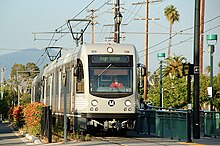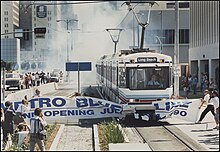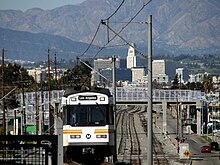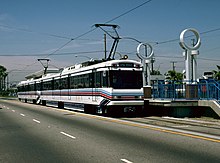The A Line (formerly and colloquially known as the Blue Line) [3] [4] is a light rail line in Los Angeles County, California. It is one of the six lines of the Los Angeles Metro Rail system, operated by the Los Angeles County Metropolitan Transportation Authority (Metro). The A Line serves 44 stations and runs east-west between Azusa and Pasadena, then north-south between Pasadena and Long Beach, interlining and sharing five stations with the E Line in Downtown Los Angeles. It operates for approximately 19 hours per day with headways of up to 8 minutes during peak hours. It runs for 48.5 miles (78.1 km), making it the world's longest light rail line since 2023.
Contents
- Service description
- Route description
- Hours and frequency
- Speed
- Station listing
- Ridership
- History
- Long Beach Line
- Pasadena Blue Line
- Foothill Extension Phase 2A
- Regional Connector
- Future developments
- Foothill Extension Phase 2B
- Southeast Gateway Line
- Current issues
- Capacity limits
- Safety at level crossings
- Operations
- Maintenance facilities
- Rolling stock
- References
- External links
The A Line is the oldest and busiest light rail line in the Los Angeles Metro Rail system, carrying over 15 million passengers in 2023, with an average of 69,216 weekday riders in May 2024. Its initial segment from Downtown Los Angeles to Long Beach opened in 1990, utilizing much of the original right of way of the former Pacific Electric Long Beach Line. Since its opening, the line has undergone numerous upgrades to improve its capacity, safety, and reliability. Plans to extend the line north to Pasadena in the San Gabriel Valley surfaced in the 1980s but were postponed due to funding constraints. The Gold Line (renamed the L Line in 2020) completed a segment of the planned extension from Union Station to Pasadena on a separate line. It opened in 2003 and extended east to Azusa in 2016.
Planning for the northern extension resumed in the early 2000s as part of the Regional Connector Transit Project, with construction starting in 2014. The project enabled A Line trains to run north to the San Gabriel Valley by constructing a light rail tunnel in Downtown Los Angeles, connecting the A Line to the L Line. The A Line's current Azusa–Long Beach service commenced in June 2023 with the completion of the project, incorporating the Union Station–Pasadena–Azusa portion of the L Line. Subsequently, the L Line ceased service, and as part of the project, three additional downtown stations opened in the constructed tunnel alignment. Construction is underway to extend the A Line further east to Pomona and Montclair.














